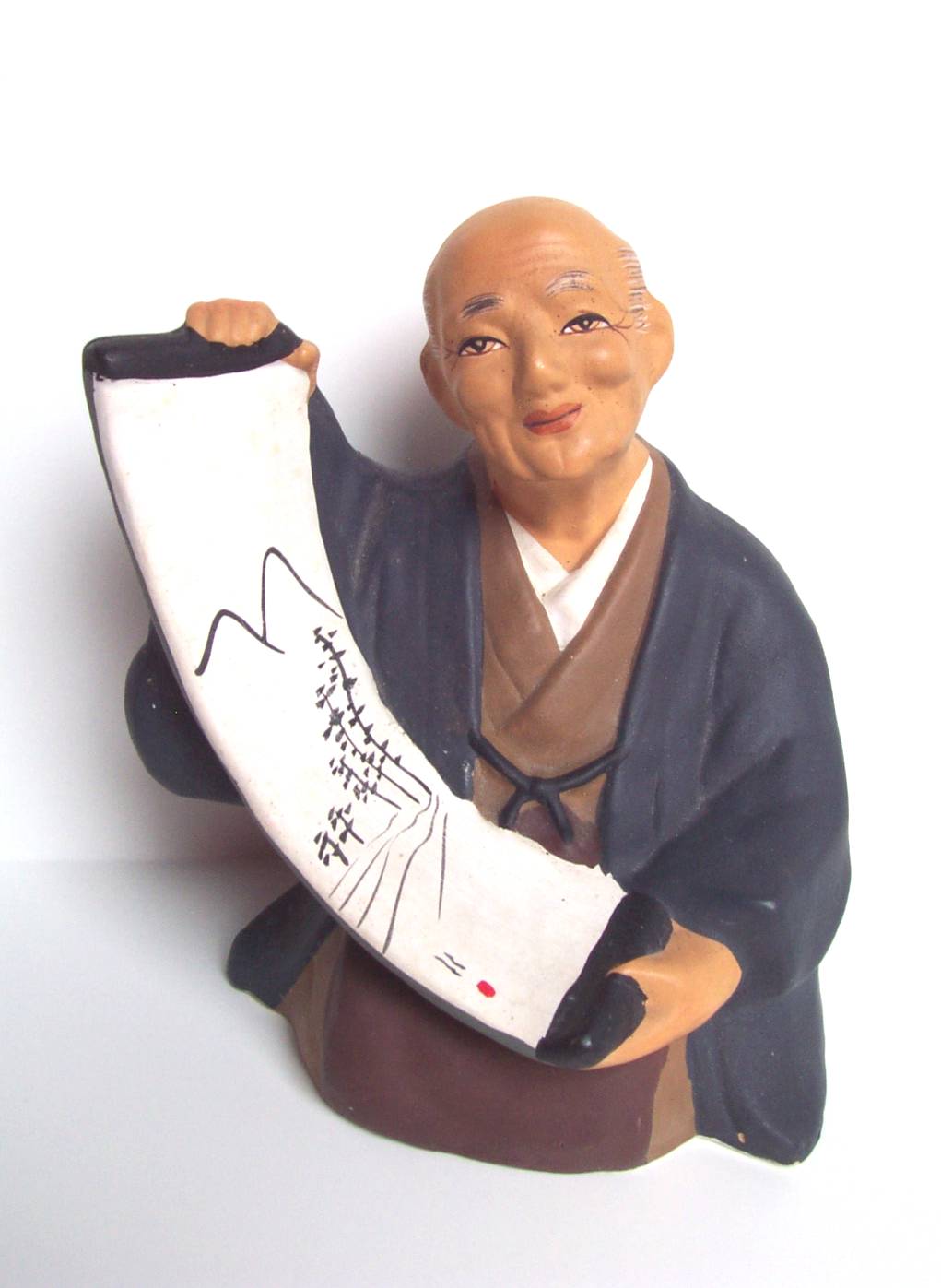To help introduce our readers to the beauty, workmanship, uniqueness, and collectability of Japanese hanging scrolls (“kakejiku”), we've prepared the following short article to offer these observations.
The Appeal of Japanese Scrolls
To collectors and admirers of Japanese woodblock prints, the addition of a few carefully selected Japanese hanging scrolls seems to be a very logical extension or broadening of one’s collection. After all, in a few cases, the artwork chosen to become mounted onto a hanging scroll is actually itself woodblock printed art. More typically, however, most Japanese scrolls are constructed using uniquely hand-painted pieces of artwork, which then become the “centerpiece” of these unique artforms.
Of course, like Japanese woodblocks, one of the reasons that make Japanese hanging scrolls a logical extension of one’s woodblock print collection is the fact that their images, too, are comprised of flat, two-dimensional artwork done either on sheets of Japanese paper or flat silk.
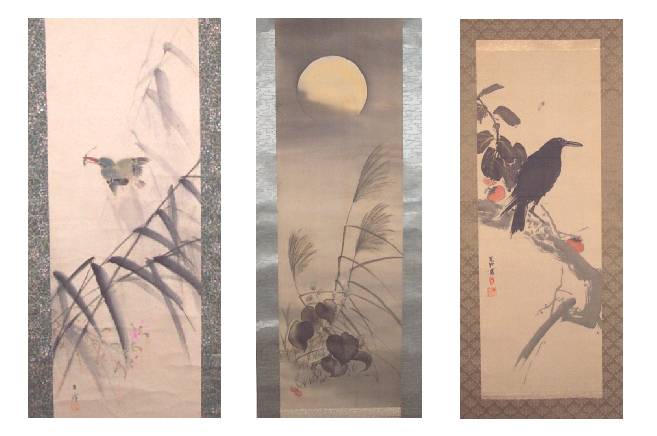
A Variety of Original Artworks can be found on Japanese Scrolls
Their Uniqueness
A significant factor which can make the acquisition of a given hanging scroll perhaps even more compelling than that of a Japanese woodblock is their UNIQUENESS. After all, the artwork seen on nearly all Japanese hanging scrolls is indeed a true one-of-a-kind piece of art. Individually and painstakingly hand-drawn, thusly, not even two "similar-appearing" pieces are alike. Hence, the added appeal of owning such a piece—the satisfaction of owning a truly unique piece of art.
Another factor supporting the acquisition of Japanese hanging scrolls as artwork is their overall intrinsic value as antiques. Their painstaking construction requires a very time-consuming and labor-intensive process. So, beyond simply the value of their unique, hand-painted artwork, each completed hanging scroll also represents numerous hours of an artisan’s time to construct. Simply stated, with Japanese scrolls you “get a lot for your money.”
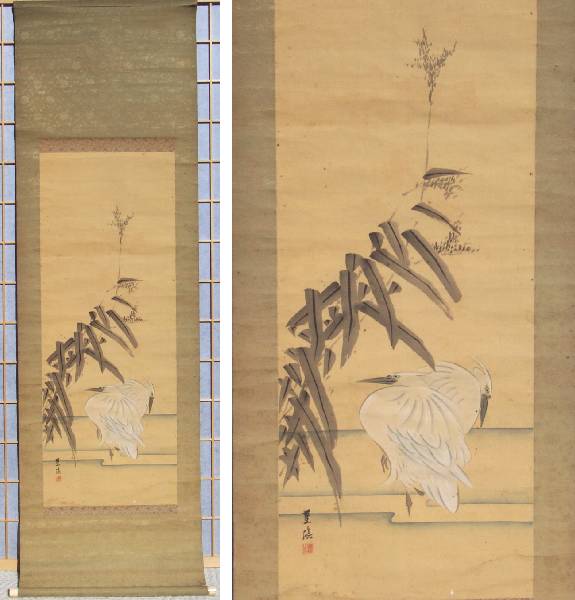
"Snowy Herons in the Reeds" Scroll--A Beautiful Meiji-era Masterpiece
Scroll Construction
At this point, we'd like to provide a few comments about a typical scroll’s construction, along with a few words of scroll vocabulary. Centered as the “focal point” of any “kakejiku” (Japanese handing scroll), of course, is it’s unique piece artwork which is usually of hand-painted pigments upon silk. Of course, in some cases, the artwork can be simply “sumi” (inks traditionally made of lamp-black carbon) sketches done on paper. Whatever the medium, typically this hand-painted artistic work is completed by an individual artist who is separate from the task of the scroll-construction process itself. In Japan, a collector or family may even commission an artwork to be created especially for their own enjoyment—which is then taken to a scroll-maker artisan to be incorporated into a scroll-mounted hanging.
The scroll construction itself is a composite of many items. All materials seen in a scroll are laid upon a fine hand-made Japanese paper backing, with the artwork itself becoming the focal point. This artwork’s margins or edges are then usually overlaid with areas of fine colored silk brocade which comprise most of the scroll’s front surface. Additional narrow strips of brocade silk (often in a contrasting color), known as “ichimonji,” are often placed as “trim” immediately above and below the artwork. Finally, many scrolls will also have two narrow silk brocade strips, known as “futai,” hanging down vertically from their top edge.
Completing the scroll is the round “roller stick" placed at its bottom. This heavy roller serves two functions—when placed in storage, the entire scroll is “rolled-up” around this roller; when hung on display, this heavy roller becomes a bottom weight, helping to prevent breezes from blowing the scroll about. Here, what “material” is chosen for the “ends” of the scroll’s roller is often an indication to collectors of a scroll’s quality and workmanship. Among scroll collectors, the most desirable (and rarest material) as “roller-ends” are those made of animal bone, antlers, or ivory tusk. Next perhaps is china. Finally, and most common, are lacquered wooden ends.
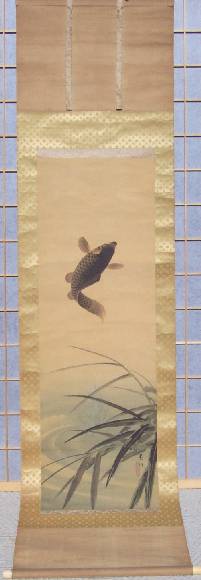
"Leaping Carp" Scroll Shows Typical Construction Elements
Scroll Weights
One final accessory is occasionally used when displaying Japanese scrolls, that being the use of “fuchin,” or what are more commonly simply called "scroll weights." Although generally not needed, a pair of these small, tasseled weights can be hung upon a scroll's bottom end-rollers if the scroll is to be hung in a somewhat "breezy" location. In some cases (if needed) these small weights can also help to hold a slightly "curled" scroll into a somewhat more straightened position. Plus, scroll weights also simply just look decorative.
A Word about Condition
Of course, as is true of many antique Japanese woodblocks, most Japanese hanging scrolls available today are often not perfect in their present-day condition. Most, it is understood, have been owned by several previous generations of collectors or admirers, and are therefore passed down to us today in varying states of condition. However, due to their highly valued nature by the families that have owned them, many of these surviving “kakejiku” do come to us today in surprisingly fine condition.
In the Japanese home, often a series of hanging scrolls would be rotated one-by-one in their honored, central display alcove area known as the home’s “tokonoma.” Many such scrolls were considered to be “seasonal,” while others might relate to specific holidays or special occasions. When not on display, they would then be carefully rolled, placed inside their protective “paulownia wood” storage boxes, then typically stored in a drawer of a nearby “tansu” (wooden dresser). At other times, a household’s cherished collection of scrolls might be stored even more safely and securely, protected away from the risk of fire in the home’s “kura” (a windowless, fire-safe storage room, typically with 12-inch thick walls).
A Word about Artist's Names and Scroll's Translations
Occasionally we are asked about the identity of the artists' whose "signatures" and "seals" appear on most of these original printings as the "artwork" seen on most scrolls. Here, quite frankly, we must tell you that the task of "reading and identifying" many of these artist's is a devilishly difficult task. Very similar in the way that an English "hand-written signature" (perhaps on letter, check, or other document) can be very difficult to "read"--so too it is with the brush-written Japanese "signatures" and "seals" seen on scrolls. Each time a "signature" is written, it varies somewhat--so the task of positively identifying an artist's "signature" is, at best, an inexact science requiring in many cases a good deal of guesswork. Hence, we've largely come to the conclusion that if the collector really wants/needs to know the artist's name, the required further research can then perhaps be undertaken by that individual (numerous references are available). That said, we largely recommend the purchase of a give scroll's artwork simply for the reason that the viewer
"likes it." That, after all, is really always the best reason for buying any artwork of any type.
The same "difficulty of translation" can also be said for the majority of the "kanji" writing seen on most Japanese scrolls. Although we would like to be able to "tell you" what is written on various Japanese scrolls, in most cases this is simply not readily possible. Again, similar to hand-written English, hand-written Japanese "kanji" characters of the 1800's and early 1900's can be extremely difficult to "read" with any certainly. Due to the "scriptive" and "calligraphic" nature of written Japanese, when one considers this fact combined with the existence of well over 3,000 various "kanji" characters in common usage, it's no wonder that "old hand-written Japanese" is so difficult to read.
A final factor is also the cryptic nature and frequent "double-meanings" of many Japanese characters. Because of this, many Japanese scrolls (as well as "surimono" and "shunga" prints) are known to be written purposely to play upon this uncertainty of translation, hence, reading the scriptive "kanji" becomes a "game" of guessing between various possible meanings. For this reason, many calligraphy,
"surimono," and "sumi-e" collectors have it as their hobby to try to figure the meaning of their pieces. Here again, we leave this endeavor to the entertainment of the purchaser.
(A selection of Japanese Hanging Scrolls are currently available for sale in our
new Gallery #8, (all are newly arrived and have come to us directly from Japan).
Conclusion
Simply stated, to a collector of Japanese woodblock prints, Japanese hanging scrolls deserve a close look. If you’ve got a tall/narrow area that's “in need” of some decoration, certainly the wide variety of Japanese scrolls available will be found to offer many choices.
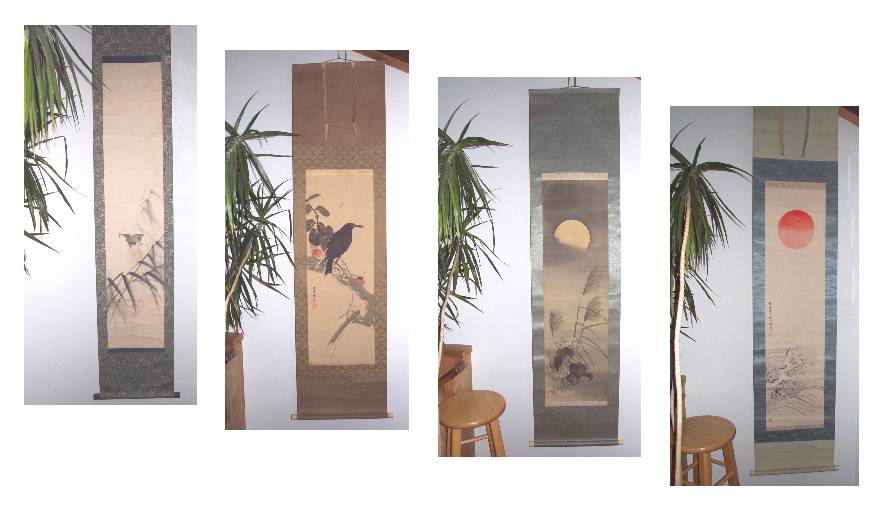
A Selection of Japanese Scrolls
(c) Thomas Crossland and Dr. Andreas Grund, April 2003 and February 2004
Gallery
Terms
Ordering
About Us
We Buy Prints
Library

Free counters provided by Andale.
